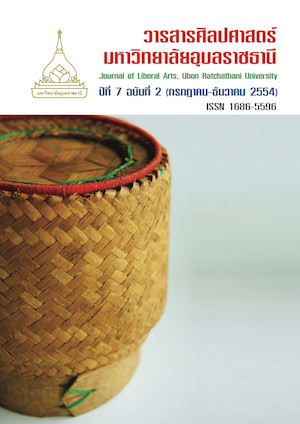A Total Quality Model for Translation and Localization: Perspectives of the Academic and the Professional Translators
Main Article Content
บทคัดย่อ
The purpose of this research is to propose a total quality model for translation and localization in the Thai environment by investigating the influences of the 7 quality indicators, namely Grammar, Context, Equivalence, Genre, Function, Format, and Management over Source text, Translation and Localization and comparing the perceptions between the Academics and the Professionals of the 7 quality indicators over Source text, Translation and Localization. A Delphi Quality Model loaded by the 7 quality indicators were rated by the purposive sample respondents consisting of 37 Academics and 38 Professionals who have adequate knowledge or ample experiences on translation and localization quality. Means and standard deviation, and t-test were used to analyze the data. The findings revealed that all the 7 quality indicators for Source text, Translation and Localization were perceived as more and most important by both groups. For Source text, the Academics perceived Grammar and Context the highest most important quality indicators and Genre the least more important while the Professionals perceived Grammar the highest most important and Genre the least more important. For Translation, the Academics perceived Grammar the highest most important indicator and Format the least more important while the Professionals perceived Context and Function the highest most important indicators and Genre the least more important. For Localization, the Academics perceived Function the highest most important indicator and Genre the least more important while the Professionals perceived Management as the highest most important indicator and Genre the least more important indicator. Relating hypothesis testing of the perceptions between both groups on the 7 quality indicators for Source text, no statistical different perception was found between the Academics and the Professionals. For Translation, perceptions between the Academics and the Professionals, only Grammar and Management were found significantly different. For Localization, perceptions between the Academics and the Professionals, Grammar, Equivalence, Format and Management were found significantly different. To conclude, it can be inferred that the Delphi Quality Model can be maintained with some addition in the proposed Total Quality Model for Translation and Localization in Thailand which is a significant outcome of this effort. An application of the Model as a quality matrix is recommended as well as directions for further studies.
โมเดลคุณภาพเชิงบูรณาการของการแปลและการแปลเพื่อปลายทาง : มุมมองของนักวิชาการแปลและนักแปลอาชีพ
การวิจัยนี้มีจุดมุ่งหมายที่จะเสนอโมเดลคุณภาพเชิงบูรณาการ สำหรับการแปล และการแปลเพื่อปลายทางในสภาพแวดล้อมไทย โดยได้ตรวจสอบอิทธิพลของตัวชี้วัดคุณภาพ 7 ตัวชี้วัด อันได้แก่ ไวยากรณ์ บริบท ประเภทตัวบท หน้าที่ รูปแบบ และการจัดการ ที่มีต่อต้นฉบับงานแปล และงานแปลเพื่อปลายทาง และเปรียบเทียบมุมมองระหว่างนักวิชาการแปล และนักแปลอาชีพในเรื่องความสำคัญของตัวชี้วัดคุณภาพ 7 ตัวชี้วัด ที่มีต่อต้นฉบับ งานแปล และงานแปลเพื่อปลายทาง โมเดลคุณภาพเชิงบูรณาการเดลฟายที่บรรจุตัวชี้วัดคุณภาพ 7 ตัวชี้วัด มีการประเมินค่าโดยผู้ตอบแบบสอบถามที่เป็นกลุ่มตัวอย่างเฉพาะเจาะจง ที่ประกอบไปด้วย นักวิชาการแปลจำนวน 37 คน และนักแปลอาชีพจำนวน 38 คน ซึ่งมีความรู้พอเพียงหรือประสบการณ์กว้างขวาง ในด้านการแปล และการแปลเพื่อปลายทาง ค่าเฉลี่ยและค่าเบี่ยงเบนมาตรฐาน ได้ใช้ในการวิเคราะห์ข้อมูล ผลของการวิจัยพบว่าผู้ตอบแบบสอบถามทั้ง 2 กลุ่มมองว่าตัวชี้วัดคุณภาพทั้ง 7 ตัวชี้วัด นั้นมีความสำคัญมากกว่า และมากที่สุดสำหรับต้นฉบับงานแปล และงานแปลเพื่อปลายทาง ในส่วนของต้นฉบับ นักวิชาการแปลมองว่าไวยากรณ์และบริบทเป็นตัวชี้วัดที่มีความสำคัญในระดับมากที่สุด และประเภทตัวบทมีความสำคัญน้อยที่สุดในระดับมากกว่า สำหรับนักแปลอาชีพมองว่าไวยากรณ์มีความสำคัญในระดับมากที่สุดและประเภทตัวบท มีความสำคัญน้อยที่สุดในระดับมากกว่า ในส่วนของงานแปล นักวิชาการแปลมองว่าไวยากรณ์เป็นตัวชี้วัดที่มีความสำคัญในระดับมากที่สุด และรูปแบบมีความสำคัญน้อยที่สุดในระดับมากกว่า สำหรับนักแปลอาชีพมองว่าบริบทและหน้าที่มีความสำคัญในระดับมากที่สุด และประเภทตัวบท มีความสำคัญน้อยที่สุดในระดับมากกว่า ในส่วนของงานแปลเพื่อปลายทาง นักวิชาการแปลมองว่า หน้าที่เป็นตัวชี้วัดที่มีความสำคัญในระดับมากที่สุด และประเภทตัวบทมีความสำคัญน้อยที่สุดในระดับมากกว่า สำหรับนักแปลอาชีพมองว่าการจัดการมีความสำคัญในระดับมากที่สุด และประเภทตัวบท มีความสำคัญน้อยที่สุดในระดับมากกว่าในการทดสอบสมมติฐานของการเปรียบเทียบมุมมองของตัวชี้วัดคุณภาพที่มีต่อต้นฉบับ งานแปล และงานแปลเพื่อปลายทาง พบว่า ในส่วนของต้นฉบับ ทั้งสองกลุ่มมีความคิดเห็นไม่แตกต่างกัน ในส่วนของงานแปล พบว่า ความคิดเห็นแตกต่างกันอย่างมีนัยสำคัญทางสถิติในเรื่องไวยากรณ์และการจัดการ ในส่วนงานแปลเพื่อปลายทางพบว่าไวยากรณ์ ความเทียบเท่า รูปแบบ และการจัดการมีความแตกต่างกันอย่างมีนัยสำคัญทางสถิติ สรุปได้ว่า โมเดลคุณภาพเชิงบูรณาการเดลฟาย อาจสามารถคงไว้ด้วยการปรับเพิ่มเติมบางส่วน เพื่อใช้เป็นโมเดลคุณภาพเชิงบูรณาการ สำหรับการแปล และการแปลเพื่อปลายทางในประเทศไทย ซึ่งเป็นผลของการวิจัยนี้ การประยุกต์ใช้โมเดลนี้เป็นเมทริกซ์คุณภาพได้มีการเสนอแนะไว้ รวมทั้งทิศทางในการดำเนินการวิจัยต่อไป


